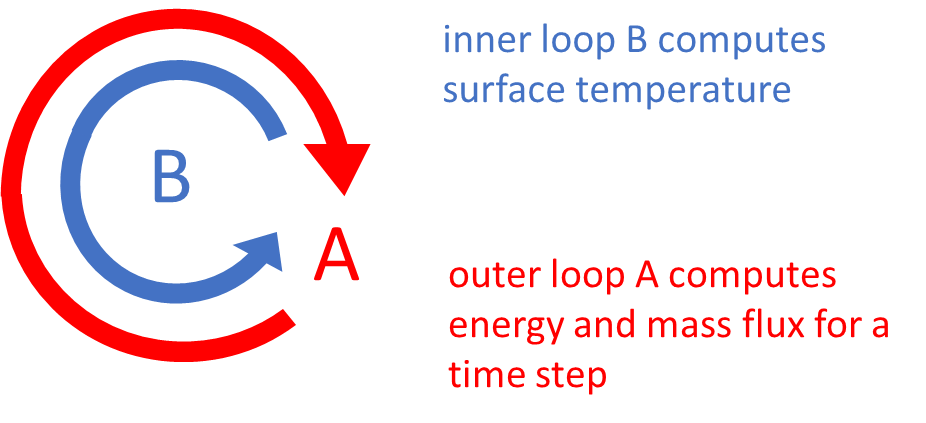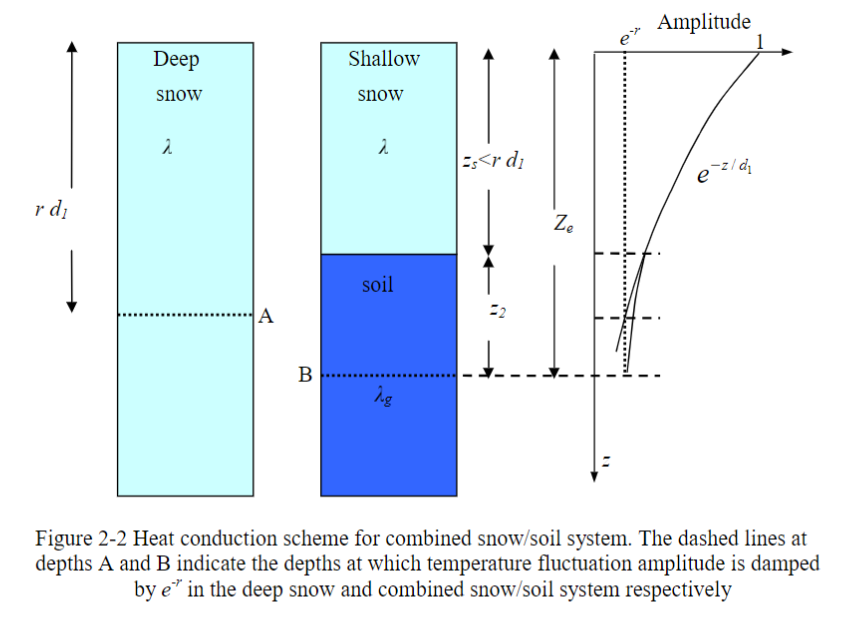Download PDF
Download page Energy Budget Method.
Energy Budget Method
Basic Concepts
The Energy Budget Method is based on the Utah Energy Balance (UEB) model (Tarboton and Luce, 1996; Luce, 2000; Tarboton and Luce, 2001; You, 2004). The UEB snowmelt model is a physically-based energy and mass balance model. Energy is exchanged between the snowpack, the air above, and the soil below.
dU/dt = Q_s_n + Q_l_i + Q_p + Q_g - Q_l_e + Q_h + Q_e - Q_m
where Q_s_n is net shortwave radiation, Q_l_i is incoming longwave radiation, Q_p is advected heat from precipitation, Q_g is ground heat flux, Q_l_e is outgoing longwave radiation, Q_h is sensible heat flux, Q_h is latent heat flux due to sublimation/condensation, and Q_m is advected heat removed by meltwater.
The current implementation of the Energy Budget method within HEC-HMS does not include reduction factors for absorption by clouds or forest cover.
dW/dt = P_r + P_s - M_r - E

The surface energy balance is:
| Q = Q_s_n + Q_l_i + Q_h(T_S) + Q_e(T_s) + Q_p - Q_l_e(T_s) |
Surface heat conduction describe the exchange of heat from the snow surface into the snowpack. Snow surface heating varies dramatically over the course of a day and over longer time periods resulting in a nonlinear temperature profile. Nonlinearity in snowpack temperature profile is largely caused by daily temperature fluctuations at the surface, which have a sinusoidal pattern.
Surface Heat Conduction
HEC-HMS uses the modified force-restore with shallow snow correction method. The force-restore method estimates the driving flux at the surface as sinusoidal (since daily temperature fluctuations follow an approximately sinusoidal pattern). However, the force-restore method may be a poor approximation because the temperature gradient does not cycle on a daily time scale. Temperature variation (and heat fluxes) with depth is caused by lower frequency fluctuations. Therefore, the heat fluxes caused by lower frequency variability are superimposed on the gradient in daily average temperature.
The low frequency effective depth d_l_f is used to associate a frequency with a distance used in the daily average gradient estimate:
| d_l_f = \sqrt{2k_g/\omega_l_f} |
where k_g is the soil thermal diffusivity, \omega_l_f is the frequency of low-frequency temperature variation, and \omega_l_f = \omega_1/4
The surface heat flux is computed as:
| Q_c_s = \frac {\lambda}{d_1} [\frac{1}{\omega_1 \Delta t} (\bar T_s - T_s_,_l_a_g_1) + (T_s - \bar T)] + \frac {\lambda}{d_l_f} (\bar T_s - \bar T_a_v_e) |
where \bar T_s is daily average surface temperature and \bar T_a_v_e is daily average depth average snowpack temperature.
The shallow snow correction involves computation of an effective thermal depth of combined snowpack and ground and a weighted thermal conductivity when the thermal damping depth extends into the ground. The shallow snowpack correction is applied when the snow depth is less than the effective depth.

Required Parameters
The Rain and Snow Threshold Air Temperatures are used to differentiate between precipitation falling as rain and snow, respectively. In particular, precipitation that falls at an air temperature above the Rain Threshold Temperature will occur purely as rain while precipitation that falls at an air temperature below the Snow Threshold Temperature will occur purely as snow. The Rain Threshold Air Temperature must always be greater than or equal to the Snow Threshold Air Temperature. Decreasing the Rain Threshold Air Temperature will cause more precipitation to fall purely as rain while increasing the Rain Threshold Air Temperature will cause less precipitation to fall purely as rain. Conversely, decreasing the Snow Threshold Air Temperature will cause less precipitation to fall purely as snow while increasing the Snow Threshold Air Temperature will cause more precipitation to fall purely as snow. These two parameters can be equivalent or differ by up to a few degrees.
The New Snow Albedo defines the albedo of freshly fallen snow. This value must be greater than the Min Snow Albedo. Increasing this value will delay snowmelt and vice versa.
The Min Snow Albedo defines the minimum albedo of aged snow. This value must be less than the New Snow Albedo. Increasing this value will delay snowmelt and vice versa.
The Albedo Refresh Depth is used to reset the snow albedo. When snow falls at a rate that exceeds this depth within a single computational time step, the albedo is reset to the New Snow Albedo. Decreasing this value will lead to the snow albedo being reset (i.e., increased) more often and vice versa.
The Albedo Decay Coefficient describes how the snow albedo decays during a computational time step. Decreasing this value will cause the snow albedo to decay slower and vice versa.
The Ground Effective Depth represents the depth of soil that will be included with the snowpack within the energy budget computations.
The Capillary Retention Fraction defines the liquid water content above which water leaves the snowpack. Increasing the Capillary Retention Fraction will delay the time at which water leaves the snowpack while decreasing and vice versa.
The Snow Hydraulic Conductivity describes how efficiently liquid water moves throughout the snowpack. Decreasing this value will delay the time at which water leaves the snowpack and vice versa.
The Snow Thermal Conductivity describes how efficiently energy is transferred within the snowpack. Increasing this value will delay snowmelt and vice versa.
The following table presents units, a summary description, allowable values within HEC-HMS, and a recommended range for each of the aforementioned parameters.
| Parameter Name | Units | Description | Allowable Range (min - max) | Recommended Range (min - max) |
|---|---|---|---|---|
| Rain Threshold Air Temperature | deg F deg C | Temperature above which precipitation falls as rain | -58.0 to 113.0 deg F -50.0 to 45.0 deg C | 32.0 to 40.0 deg F 0.0 to 4.4 deg C |
| Snow Threshold Air Temperature | deg F deg C | Temperature above which precipitation falls as snow | -58.0 to 113.0 deg F -50.0 to 45.0 deg C | 30.0 to 35.0 deg F -1.1 to 1.7 deg C |
| New Snow Albedo | - | Albedo of fresh snow | 0.0 to 1.0 | 0.6 - 0.95 |
| Min Snow Albedo | - | Minimum albedo of aged snow | 0.0 to 1.0 | 0.1 - 0.5 |
| Albedo Refresh Depth | in mm | Depth of new snow at which albedo is reset | 3.94E-04 to 0.394 in 0.01 to 10 mm | 0.02 to 0.2 in 0.5 to 5.0 mm |
| Albedo Decay Coefficient | hr | Describes how albedo decays from new snow albedo to min snow albedo | 1.0 to 600 hr | 40 - 400 hr |
| Ground Effective Depth | ft m | Soil depth that is included within the energy budget computations | 3.28E-03 to 3.281 ft 0.001 to 1.0 m | 3.28E-03 to 3.281 ft 0.001 to 1.0 m |
| Capillary Retention Fraction | - | Amount of water that can be held within the snowpack | 0.001 to 0.25 | 0.03 to 0.05 |
| Snow Hydraulic Conductivity | ft/s m/s | Describes how efficiently liquid water moves throughout the snowpack | 3.28E-4 to 0.328 ft/s 0.0001 to 0.1 m/s | 3.28E-4 to 0.328 ft/s 0.0001 to 0.1 m/s |
| Snow Thermal Conductivity | Btu/ft/deg F/hr J/m/deg C/hr | Describes how efficiently energy is transferred within the snowpack | 0.017 to 0.17 Btu/ft/deg F/hr 100 to 1100 J/m/deg C/hr | 0.02 to 0.1 Btu/ft/deg F/hr 125 to 1000 J/m/deg C/hr |
A Note on Parameter Estimation
Regardless of the source of information used to estimate initial parameter values, including the table presented above, all Hybrid snow parameters must be calibrated and validated.
Required Boundary Conditions
In addition to parameters, the Hybrid snow method requires the following meteorologic boundary conditions:
- Shortwave Radiation
- Longwave Radiation
- Precipitation
- Temperature
- Windspeed
- Pressure
- Dew Point and Humidity
Tutorials describing example applications of this snowmelt method, including parameter estimation and calibration, can be found here: Calibrating Gridded Snowmelt: Upper Truckee River, California and Calibrating Point Snowmelt: Swamp Angel Study Plot, Colorado.
A tutorial illustrating how to use the Uncertainty Analysis to evaluate Hybrid Snow parameter sensitivity can be found here: Evaluating Energy Budget Snowmelt Parameter Sensitivity.
Descriptions of the user interface features pertaining to this method can be found here: Gridded Energy Budget Snow section of the User's Manual.